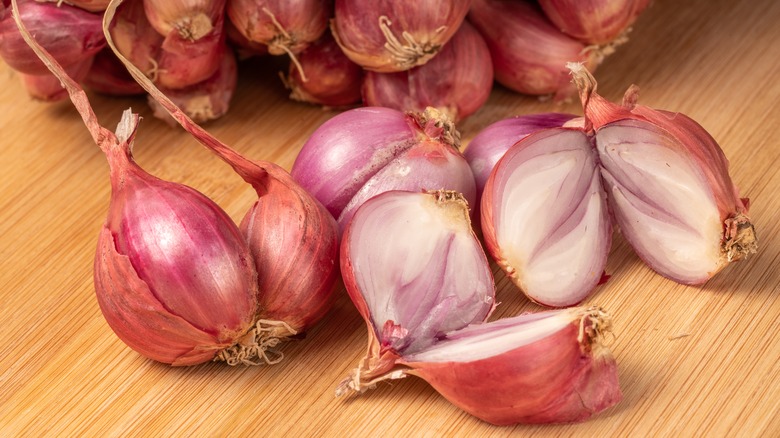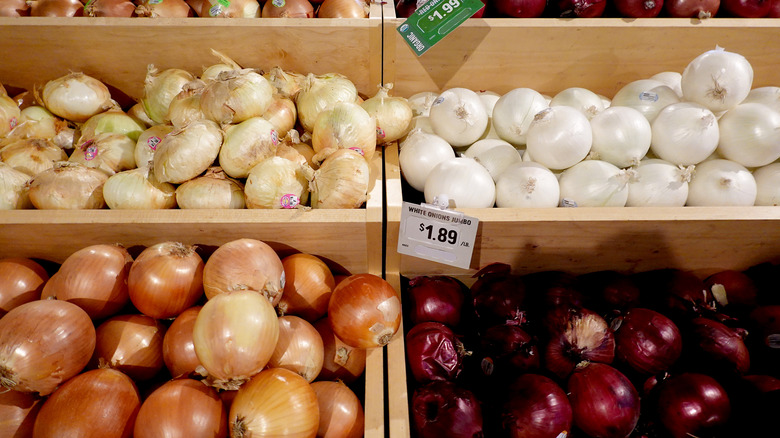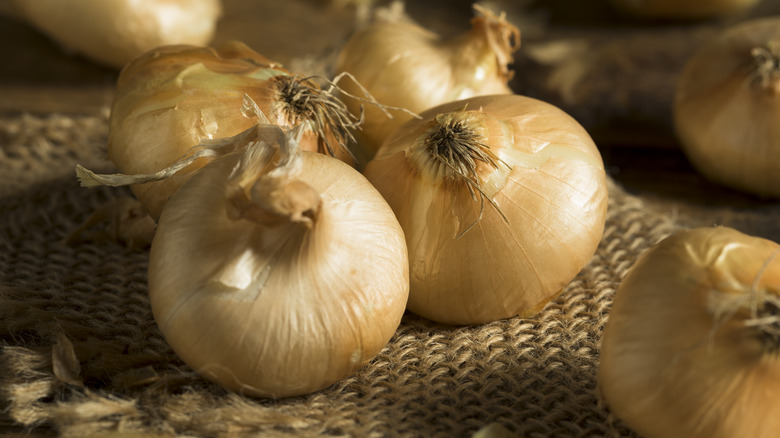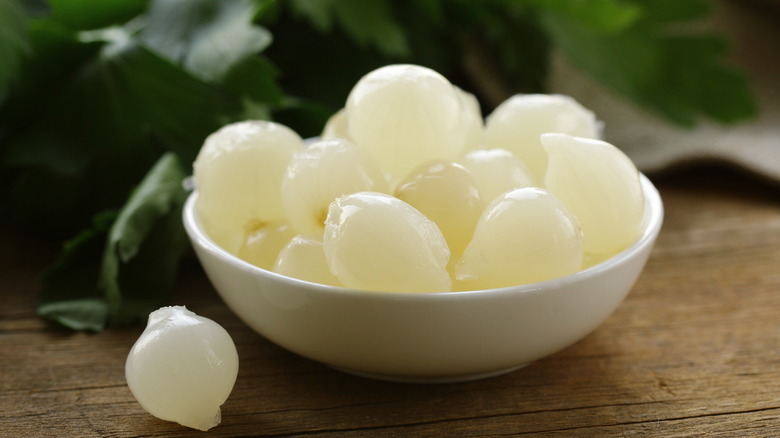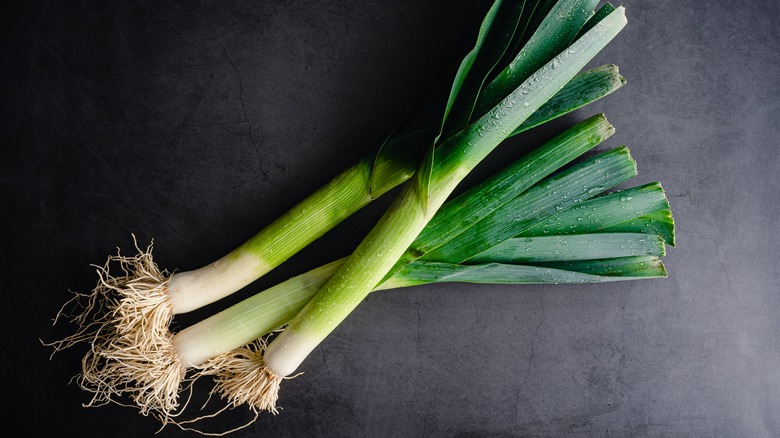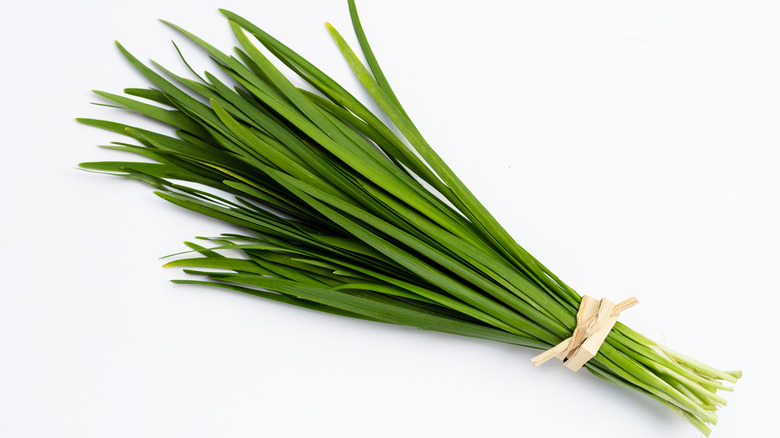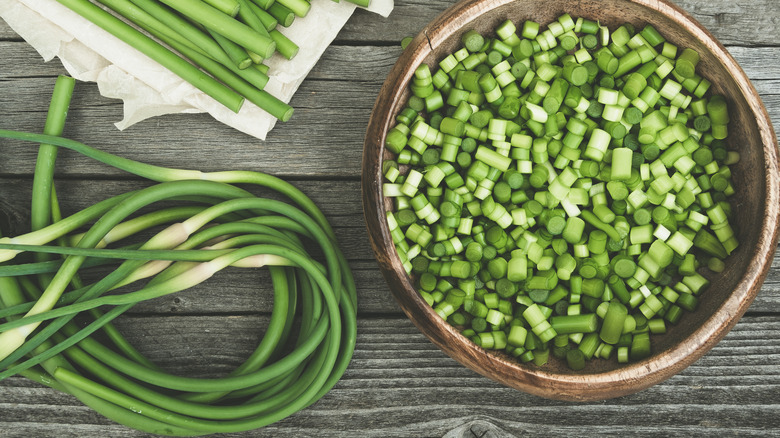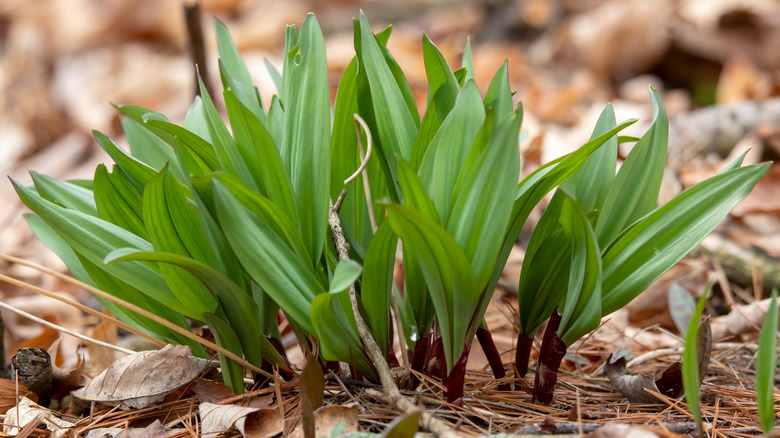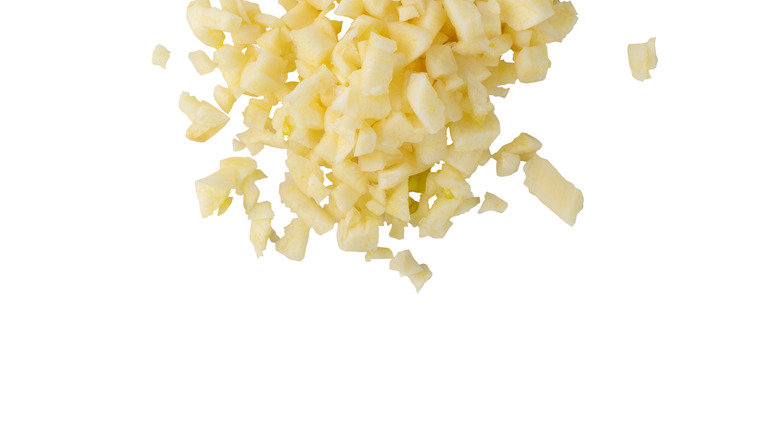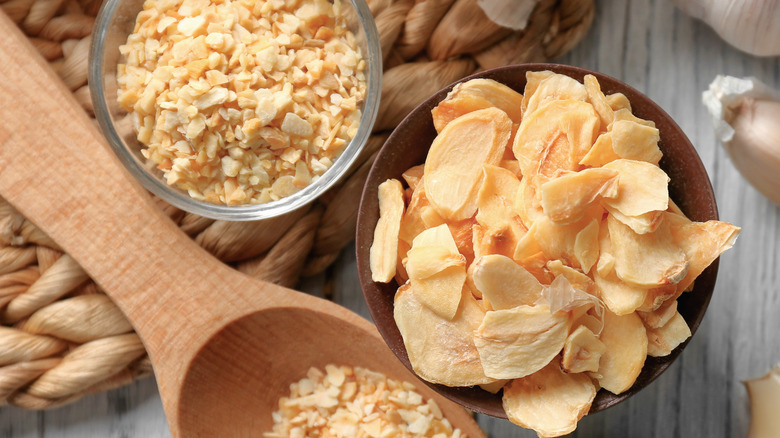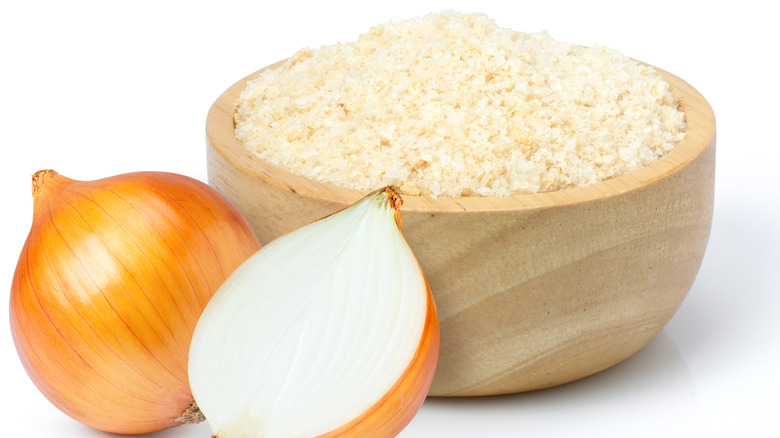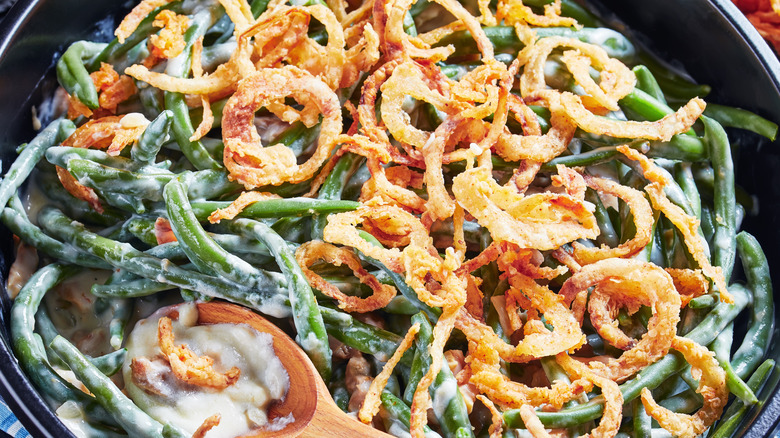The Absolute Best Substitutes For Shallots
We may receive a commission on purchases made from links.
Shallots are cousins to onions, garlic, and leeks, making them a member of the allium genus. Shallots resemble a smaller onion, and sometimes have a bit of a tear-drop shape, and range in color from purplish to rust. Shallots also taste milder than an onion, but are distinct in that they have cloves without the no papery skin of garlic. This bulb can be confusing since green onions are called shallots in some parts of the world, while in others, shallots are called green onions (via Onions Australia).
Because of the mild flavor, there is quite a bit you can do with shallots: They're great raw in salads or dressings, or, you can pickle shallots. Try frying them up as garnishes. You can even use them in baked goods or casseroles — the possibilities are nearly endless. Among other things, shallots are a good source of iron, folate, and magnesium, according to the USDA. A study published by the American Association for Cancer Research says an antioxidant found in the allium family might help in the fight against cancer.
But, what if you can't find any at your local grocery store or if you've run out and need a quick replacement? We compiled multiple options for you to substitute shallots for other ingredients.
Swap-in storage onions
Close your eyes and picture an onion. The image that came to your mind is probably a storage onion, which makes sense since they are one of the most popular types of onions. Storage onions are round yellow, white, and red onion bulbs with papery skin that you can get year-round at any grocery store. These bulbs come in different sizes and varieties, and some are sweeter than others. Because of their availability, storage onions are the most accessible replacement for shallots.
Which storage onion you should use to replace shallots depends on what function shallots serve in your recipe. For instance, yellow onions are a good substitute in cooked applications because of the milder flavor. Red storage onions are milder when eaten raw, making them a better substitute when you need raw shallots in a recipe. White ones, meanwhile, are a good balance between the two and can be used in either application. Onions are stronger tasting than shallots, so in raw dishes, start with less and add more to taste.
Choose cippolini onions
It wasn't always the case, but Italian onions are now pretty easy to find across the United States. Cippolini is Italian for "little onion," which is precisely what these onions are. Cippolini onions are a good substitute for shallots due to their diminutive size and sweeter nature. They come in white, yellow, and red — just like big storage onions. The difference is that they aren't bigger than 3 inches in diameter and are flat, according to Johhny Seeds.
Cippolini onions also have 6 grams of sugar per 100 grams, and shallots have around 8; meanwhile, storage have less than 6 grams (per U.S. Branded Foods). Cippolinis' higher sugar content makes them great for caramelizing and roasting, so keep that in mind when using them in place of shallots. Try using cippolini onions instead of shallots in this confit recipe. A jam-like condiment is a perfect application for cippolini onions.
Pick pearl onions
Pearl onions are actually storage onions that are grown in such a way that keeps them from getting big. Speciality Produce says farmers plant them close together and harvest them early to ensure they don't have a chance to grow big. Pearl onions' small size makes them a good substitute for shallots since they are close in size. Because pearl onions are small storage onions, they come in all colors: yellow, white, and red.
While these small bulbs are a great substitute for shallots, peeling pearl onions can indeed be a bit of a hassle. Try blanching them first to streamline the removal process. Once you have dealt with their skin, you can do many things with pearl onions that you can do with shallots. One thing you can do is pickle them, or try making pearl onion jam instead of using shallots in this jam recipe.
Got to love leeks
While leeks aren't onions, they are members of the same genus — allium — to which shallots also belong. So, it stands to reason that they'd be worthy shallot substitutes. While you don't need to cook leeks before you eat them, most people prefer them that way. With that in mind, we recommend using them in baked goods and soups.
The green part of a leek is tougher than the white, and many people don't eat them (but you definitely should). Leeks can be the star of the show or the supporting player, so keep that in mind as well. Leeks have the downside of being hard to clean. You need to cut leeks open and either run them under the faucet or put in a bowl of water to remove any residual dirt or sand. You might have to repeat the process to ensure you get rid of everything.
Besides being tasty, leeks have a lot of nutrients, such as high amounts of calcium, potassium, vitamin C, and beta carotene — shallots are stillHEro higher in protein and potassium, however (via USDA).
Choose chives
Chives are an herb in the allium family that is often used as a garnish or a last-minute mix-in. From potatoes to compound butter, there are so many ways to use chives. You can also use the flowers in salads and vinaigrettes, which would be a stunning replacement for shallots. Though if you want chive flowers, you will probably need to grow your own. Chives are an excellent shallot substitute for dishes that require a more subtle onion-garlicky flavor.
There are two types of chives: European and Chinese. According to FoodPrint, the Chinese chives are much better for cooking since they are more fibrous. In contrast, the tender European chives make better herb garnishes. The outlet states that while the flavor differences are subtle, they both pair well with fat.
Chives have a very distinct flavor. Depending on your point of view, that different flavor can be a good or bad thing when using it as a substitute. While it won't taste exactly the same, chives would be a nice swap-out in this shallot mignonette recipe. You can also swap them out for shallots in other sauces and dressings.
Go with garlic scapes
Garlic scapes are garlic stems and have a milder flavor than garlic. In fact, people often compare the taste to shallots. You really can use them just about anywhere you'd use shallots because you can eat garlic scapes raw or cooked. FoodPrint suggests selecting scapes that are firm but still pliable.
The Farmer's Almanac says garlic scapes are packed with calcium, vitamin C, and protein. Because they're young garlic stems, you will only find them in markets or CSA boxes in late spring and early summer since that's when garlic is beginning to grow its shoots. Of course, you can always plant your own garlic. The outlet recommends harvesting scapes before they flower so your garlic plant can send its energy to its bulb.
If you are looking for ways to eat more sustainably, garlic scapes are a great idea since they take advantage of part of the plant that would otherwise be thrown away. So perhaps, you even should substitute your shallots for scapes at this time of year to take advantage of this special treat.
Select scallions, green onions, or spring onions
Scallions, green onions, and spring onions are all immature onions at various stages of growth; the younger they are, the milder the flavor. As shallot replacements, the younger, milder scallions work well in raw dishes. In contrast, the more mature, spicier onions are better when cooked. Somewhat confusingly, people often refer to these veggies interchangeably, and you'll often see them in the store that way, too. To add more fuel to the fire, Cooks Info says that some people say green onions and scallions are actually different plants, owing to the fact that they grow from different types of onions.
If you've ever wondered why some scallions are round and some are flat, that's because they're different types of onions. According to Cooks Info, the round scallions are from bulb/storage onions, while the flat ones are from bunching onions, and some would say, are the true green onions. In the U.S., as a general rule of thumb, scallions are the youngest form of this onion, and for that reason, they don't really have a bulb. According to most people, green onions are the next stage in maturity and have a slightly discernible bulb. Spring onions have a clearly developed bulb and the sharpest taste.
Replace with ramps
Ramp vegetables are a wild allium that tastes somewhere between garlic, scallions, and leeks. They are only available during the spring, so even if you don't have to, try swapping them in for shallots as a special, seasonal treat. Ramps are pretty strong raw, so we recommend that you use these in recipes that require cooking — unless you're ready for a kick, that is. Ramps resemble scallions but with broader leaves and purply bulbs. While ramps aren't as challenging to clean as leeks, they take more preparation than scallions or storage onions.
Be careful if you decide to go ramp-foraging on your own, though. You could risk confusing ramps with its poisonous cousin, lily of the valley. Moreover, since over-harvesting has become a concern and put vegetable populations at risk. Some U.S. states have placed restrictions on foraging, so check restrictions in your area (per FoodPrint).
If it's ramp season, consider using them in a quiche or pickling them instead of shallots.
Make use of minced garlic
Garlic is an excellent substitute for shallots since the two are closely related. Many recipes call for chopped or sliced shallots to be used as an aromatic to impart flavor to the dish in the early stages of cooking. This application is a great place to consider swapping in garlic. And cutting your garlic into small pieces, i.e., mincing it, will incorporate throughout the dish.
In fact, the real reason some ingredients need to be minced is so the original texture disappears into the dish and only leaves behind its flavor. Besides, since these flavors are usually so intense, getting a large bite of a piece of shallot or garlic can disrupt the balance of the dish. Use approximately 1 teaspoon of garlic (one clove) for every ½ teaspoon of shallot that your recipe needs.
If you have ever wondered how to mince garlic properly without a garlic press, here's how: Use a fork. While that's not technically mincing by culinary definition, it will get the job done. Remove the garlic skin, place the clove on your cutting board and press down.
Go with granulated or powdered garlic
Because garlic and shallots are so closely related, what you substitute for garlic often works for shallots. In a pinch, you can use garlic powder or granulated garlic to impart the intense flavor of allium into your dish. Both are two variations of dehydrated garlic. The difference is basically the size and texture of their grain. If you need shallots for salad dressing or something liquid, try going with granulated garlic over powder, as its bigger grains make a better substitute for fresh alliums. You could even try reconstituting it.
Remember that dried spices are more potent than fresh in general, and powdered garlic is stronger than granulated. That makes it a good choice for dishes that cook fast. For garlic powder, you should use ⅛ a teaspoon of garlic powder for every teaspoon of shallots you need. In the case of granulated garlic, you can do a 1:1 ratio.
A significant advantage to these replacements is their long shelf-life. While most spices stay their freshest about one to two years, Still Tasty says you can keep your garlic powder for double that.
Opt for onion powder or flakes
Onion powder is often created by dry roasting and grinding more than just the bulb. This method results in strong umami and concentrated flavor, so a little goes a long way. The Kitchen Chalkboard recommends using 1 tablespoon of onion powder for every ½ cup of fresh shallots your recipe requires.
Onion flakes are essentially onion powder before it has been ground and, because it comes in larger pieces, are a better replacement in most of your shallot recipes. But remember, they are also stronger than fresh allium, so you'll need to use less here. Try 1 tablespoon in place of ½ cup of fresh shallots.
If you prefer shallots to onions, but they're hard to get in your area, you can purchase freeze-dried shallots. Or, if you finally do find shallots, but know you can't use them all before they go bad, you can even dehydrate shallots for later use. Once you have dried them, you can grind them into powder.
Fill in with french-fried onions
Many recipes call for crispy, fried shallots atop the dish. Fortunately, you can use packaged "french-fried onions" instead. A lot of people buy French-fried onions for Thanksgiving green bean casserole. But, what do you do with them afterward? Even though French's states that properly stored, its fried onions have a shelf-life of two years, you might not want to wait for next November to roll around before using again. Instead, you can use your french-fried onions the next time you are out of shallots.
You should know that french-fried onions are usually made with yellow storage onions, so they won't be quite as sweet as shallots. They're also coated in flour, whereas home-fried, crispy shallots are probably just naked.
If you need a crispy-shallot replacement, try french-fried onions as a topper on a modern wedge-salad recipe. You can also try them on a congee with pickled plums, fried shallots, and chives recipe. You may not be sure where to find french-fried onions; they're usually stocked with canned foods or the condiment aisle at the grocery store, says Info Grocery.
Adopt asafoetida
Sometimes you need to substitute shallots because you can't eat them. And chances are that if you can't eat shallots, you might be avoiding other foods in the allium family. That's where asafoetida makes an excellent substitute for shallots. Healthline says that asafoetida is the dried sap of the Ferula plant, so no worries there. Asafoetida is common in Indian cooking, where it's called hing, says Healthline.
It's particularly popular among people who follow Jain and Brahmin diets since they don't eat root vegetables, according to The Spice People. If your avoidance of shallots is in the name of digestion, keep in mind that asafoetida is a good option for those on a low-FODMAP diet, where people remove certain foods to identify their gastrointestinal issues. Note that because of additives used to make asafoetida powder, it is not gluten-free.
You can "bloom" this spice's flavor by cooking it in oil or another fat before continuing with your recipe as normal. Remember that a little goes a long way: Asafoetida is much stronger than shallots are, so start with less and add more if you need to. Also, since shallots add a sweetness that this spice won't, you may need to adjust the sugar levels in your dish (via Spice and Life).
